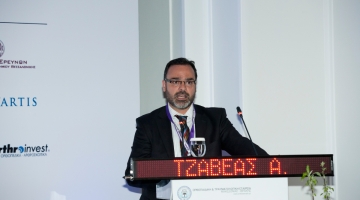Treatments
Hip
 Considering the painful hip in youth and athletic adults as "hip strain", "idiopathic hip pain" or "mild osteoarthritis" was a common practice until about 10 years ago.
Considering the painful hip in youth and athletic adults as "hip strain", "idiopathic hip pain" or "mild osteoarthritis" was a common practice until about 10 years ago.
However, MRI with and without contrast medium has provided a better understanding of the pathology of the hip. More recently, hip arthroscopy has contributed greatly not only to the confirmation of lesions identified on magnetic resonance imaging, but also to their treatment.
Hip arthroscopy is now a widely accepted method for the surgical treatment of many diseases of the joint. Conditions that required a long incision, wide releases and detachment of soft tissues and dislocation of the hip joint, now they can be treated through three small holes, about 1 cm each. An open surgical method is associated with increased morbidity and high rate of intraoperative and postoperative complications and requires the patient's stay in the hospital for a few days.
On the other hand, the arthroscopic method minimizes the likelihood of complications and the patient returns the same day at home. However, both the patient and the doctor must not forget that all surgical techniques have complications and that the hip joint requires intensive postoperative rehabilitation.
Disease treated with hip arthroscopy
Open surgeries
Intra-articular injections
Knee
 The knee is the most complex joint of the human body, consisting of three different compartments (medial, lateral and patello-femoral) and formed by four different bones (femur, tibia, fibula and patella).
The knee is the most complex joint of the human body, consisting of three different compartments (medial, lateral and patello-femoral) and formed by four different bones (femur, tibia, fibula and patella).
The loadings that sustains, combined with the wide range of its movements make it vulnerable to major or minor injuries. Also it is the most common joint to develop degenerative lesions, particularly in old age, and in patients with an increased body weight.
Knee arthroscopy
Total knee replacement
Common orthopaedic diseases
Much of the practice of an orthopedic surgeon involves conditions created by the modern sedentary lifestyle, professional diseases (overuse injuries) or, in the case of athletic individuals, simple sports injuries. These problems are addressed more often with conservative treatment, physiotherapy or medication, following proper medical advice.
However, diseases with symptoms that do not subside with conservative means require surgery. It is essential to understand that many orthopedic problems mainly affect the quality of life, and the patient himself should decide for the need of an orthopaedic operation.
Back pain (pain in the "middle")
Neck (cervical syndrome)
Carpal Tunnel Syndrome








